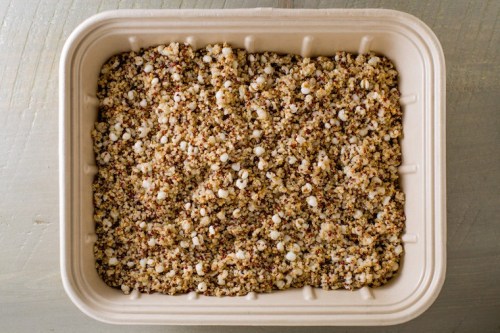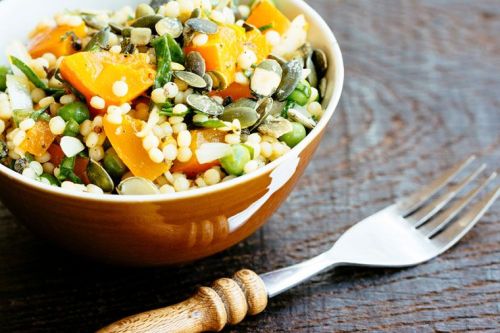Our editors independently select these products. Making a purchase through our links may earn Well+Good a commission
If oatmeal, quinoa, and brown rice are your go-to staples, you’ve likely encountered a phenomenon known in wellness circles as grain fatigue (a close cousin of salad fatigue). But how do you switch things up while still keeping your bowl healthy? By adding an often-overlooked gluten-free grain to your rotation: Job’s tears (also called coix seed).
The ancient grain, which is grown primarily in Southeast Asia, has more protein than all other cereal grains, is good for the environment because it doesn’t require a lot of water to grow, and happens to taste delish. As if that wasn’t enough to temp you, it’s actually been shown to ease period cramps more effectively than an over-the-counter medicine. Yes, for real!
Scroll down to learn more about the health benefits of Job’s tears, plus how to incorporate it into your meals.

The nutritional 411
“I can definitely see Job’s tears becoming a new popular trend because it really does have a lot of great health benefits,” says nutritionist and Nutrition Journey founder Anna Baker. She says it’s especially good for vegans and vegetarians because not only is it high in protein—packing approximately 6 grams per half cup—but it also has essential amino acids and vitamin B, which are typically sourced from meat.
Baker explains that it’s also easier on the digestive system. “One study found that it [protects] the GI system and actually works to reduce ulcers in mice by helping increase good bacteria in the gut,” she says. If a grain bowl tends to make you bloated, it might be worth mixing your regular go-to grain with some Job’s tears, which work to protect the lining in your digestive track. And while it’s working to improve your gut, it’s also lowering cholesterol. Talk about a multitasker!
But the benefits don’t stop there. Baker says in Southeast Asia, it’s brewed as a tea and sipped to ward off allergies. “The extract has been shown to minimize the symptoms of hay fever,” she says.
Because Job’s tears are anti-inflammatory, researchers are starting to study it for cancer treatment and prevention, which is proving to be a good hunch. One study found that the grain reduced tumor growth in mice.

How to cook with it
Job’s tears is already on the menu at the popular New York City healthy outpost The Little Beet, in their gluten-free ancient grains blend. “When I was coming up with the [fall] menu, I was digging around for some less common non-glutenous grains that I could blend together for an agreeable texture,” says Gabe Kennedy, the restaurant’s chef. (You might recognize him from winning The Taste, too.) “I love the texture, size, and taste of Job’s tears,” he says. “The taste is like a mix between rice, pearl barley, and hominy.”
The more Kennedy learned about the grain, the more excited he got to integrate it into The Little Beet’s menu. “I really geek out on plants,” he says. He even vaguely remembers trying it in tea form as a kid. “My mom is a Chinese herbalist and acupuncturist, so I think I had it a long time ago, but never really connected the dots,” he says.
Having experimented with it in the kitchen a lot at this point, Kennedy offers up a few tips: First, don’t expect it to work as a bowl base. “Because of the size and texture, it’s more well-suited for adding into soups, salads, oatmeal, and grain bowl blends,” he says. Another reason why you’ll want to blend it: Job’s tears are also more expensive than other grains on the market. As far as cooking it goes, all you do is toss ’em in a few inches of boiling water and let them cook until they’re chewy. “They’re pretty hard to mess up,” Kennedy says.
The water the grain is cooked in has great medicinal properties, so both Kennedy and Baker say it shouldn’t go to waste. At The Little Beet, Kennedy uses the water in the restaurant’s soups for added nutritional value and extra flavor.
If you can’t find Job’s tears locally (pro tip: shop the Chinese, Japanese, or Korean markets), you can find them the one place everything is for sale: Amazon. And just like that, you can give your grain bowl a makeover. “The world of plants is so diverse, robust, and expansive,” Kennedy says. “Being able to discover interesting plants that have been around for thousands of years but are new to me is really exciting. It makes me inspired and keeps my job interesting.”
Now that your grain bowl is fun again, here are 14 ways to get out of your salad rut—all wellness influencer-approved. Pinole is another super-grain worth experimenting with, too.
Sign Up for Our Daily Newsletter
Get all the latest in wellness, trends, food, fitness, beauty, and more delivered right to your inbox.
Got it, you've been added to our email list.











